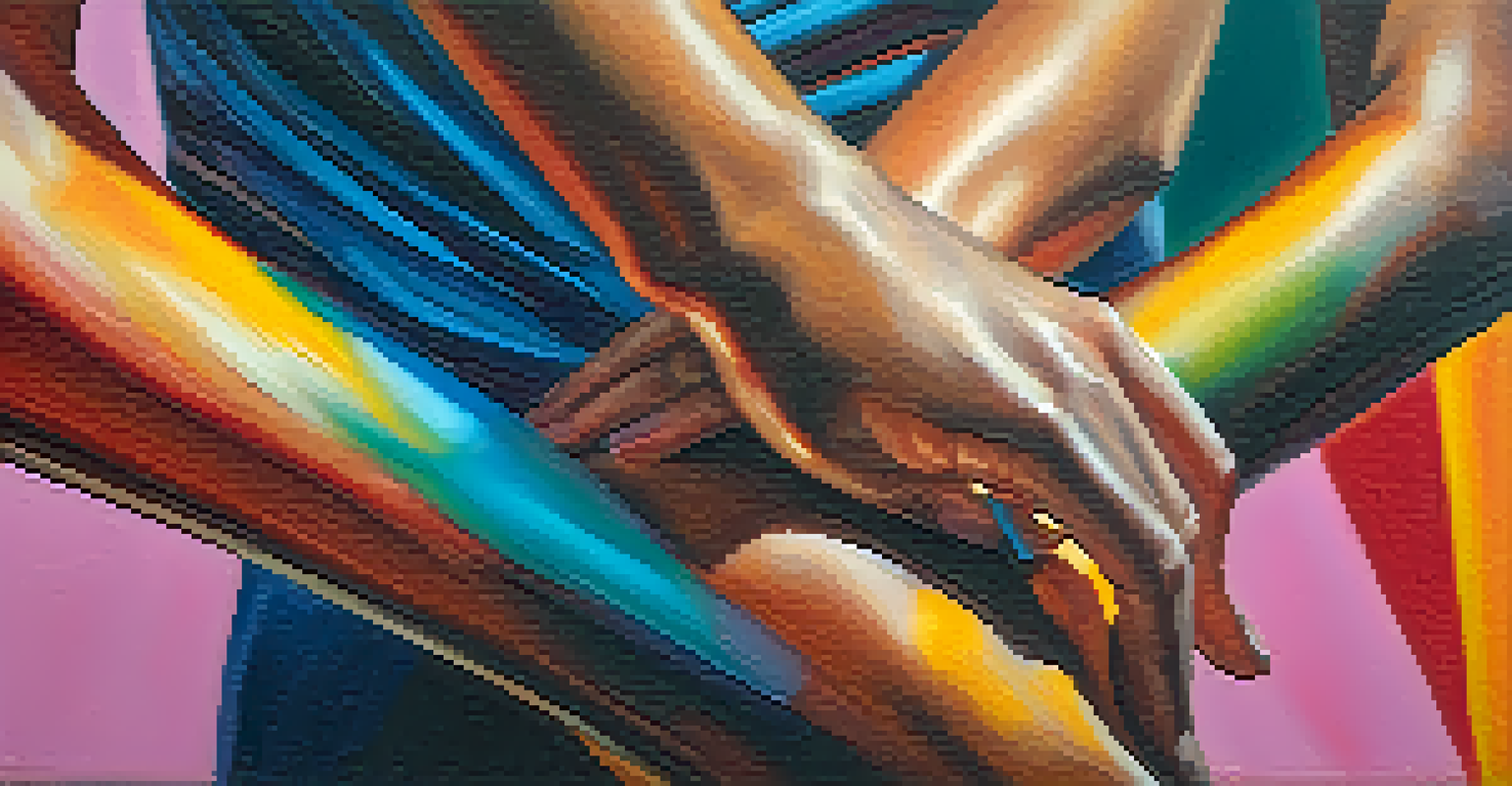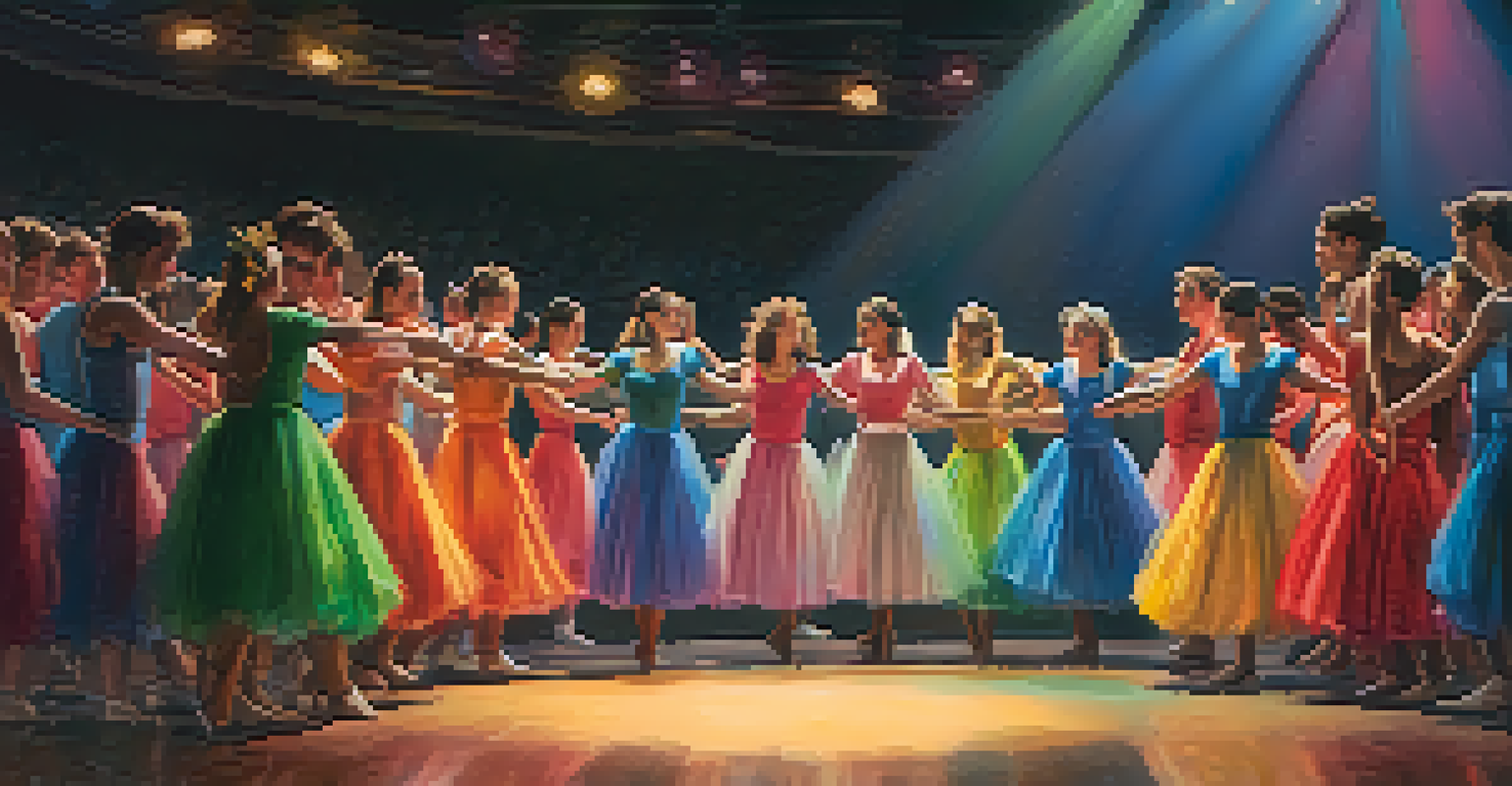Common Symptoms of Performance Anxiety Among Dancers

What is Performance Anxiety in Dancers?
Performance anxiety is a psychological condition that many dancers experience, often leading to significant stress before or during a performance. It can manifest as nervousness, fear of judgment, or an overwhelming sense of pressure to succeed. Understanding this phenomenon is crucial for dancers to manage their mental health and performance effectively.
Anxiety is like a rocking chair. It gives you something to do but gets you nowhere.
The anxiety is not just about the fear of making mistakes; it can stem from the desire to meet personal or external expectations. Dancers often feel that their worth is tied to their performance, which can intensify these feelings. The more they care about their art, the more susceptible they may become to anxiety.
Recognizing performance anxiety as a common issue can help dancers feel less isolated and more empowered to seek strategies for coping. It’s essential to create an environment where discussing these feelings is normalized, allowing dancers to share their experiences and support each other.
Physical Symptoms of Performance Anxiety
Dancers often experience physical symptoms that accompany their anxiety, such as sweating, trembling, or a racing heart. These bodily reactions can be quite alarming, especially when one is about to perform. They are the body's way of preparing to face a perceived threat, but in a performance setting, they can be counterproductive.

For instance, a dancer might feel their palms getting sweaty or their legs shaking right before stepping on stage. This physical response can sabotage their confidence and focus, making it difficult to execute movements smoothly. It's like trying to perform while your body is in fight-or-flight mode.
Understanding Performance Anxiety
Performance anxiety is a common psychological condition among dancers, stemming from the pressure to meet personal and external expectations.
Recognizing these symptoms is the first step toward managing them. Techniques like deep breathing, visualization, and physical warm-ups can help to alleviate these physical manifestations, allowing dancers to regain control of their bodies before they take the stage.
Emotional Symptoms of Performance Anxiety
Emotional symptoms can be just as debilitating as the physical ones, often manifesting as feelings of dread, panic, or self-doubt. Dancers may find themselves ruminating on potential mistakes or worrying about how they will be perceived by the audience. These thoughts can create a vicious cycle that heightens anxiety even further.
Your talent is your gift, but your anxiety can often feel like a weight. Learning to manage it is the key to letting your talent shine.
Imagine standing backstage, heart racing, while thoughts swirl about whether you'll forget your choreography or disappoint your teachers and peers. This emotional turmoil can sometimes overshadow the joy of performing, transforming what should be a celebratory moment into a source of distress.
Addressing emotional symptoms requires a multifaceted approach, including mindfulness practices and cognitive-behavioral strategies. Dancers can benefit from learning how to reframe negative thoughts, replacing them with affirmations or focusing on the joy of sharing their art with others.
Cognitive Symptoms of Performance Anxiety
Cognitive symptoms refer to the mental processes that can become disrupted due to anxiety. Dancers may find it challenging to concentrate, leading to forgetfulness or difficulty recalling choreography. This cognitive overload can create a feedback loop, where anxiety makes it harder to focus, which in turn increases anxiety.
A dancer might experience a moment on stage where they completely blank out, unable to remember the next step. This can be devastating and can reinforce the fear of future performances. It’s akin to a computer freezing when too many applications are running at once; the system just can’t handle the pressure.
Recognizing Symptoms is Key
Physical, emotional, cognitive, behavioral, and social symptoms of performance anxiety can significantly impact a dancer's ability to perform.
To combat cognitive symptoms, dancers can practice mental rehearsal techniques, visualizing each step of their performance in a calm and focused manner. This not only helps to build muscle memory but also reinforces confidence and clarity when it’s time to perform.
Behavioral Symptoms of Performance Anxiety
Behavioral symptoms often manifest as avoidance or changes in performance habits. Dancers may skip rehearsals, decline performance opportunities, or even withdraw from classes altogether. This avoidance can have long-term effects on their growth and passion for dance.
For example, a dancer who used to thrive on stage may suddenly refuse to participate in showcases, fearing the anxiety that performing brings. This withdrawal can lead to isolation, making it even harder to overcome performance anxiety and reconnect with their love for dance.
Encouraging open discussions about these behavioral changes within the dance community can help combat this issue. When dancers feel supported and understood, they’re more likely to confront their fears and gradually re-engage with performing.
Social Symptoms of Performance Anxiety
Social symptoms often arise from the fear of judgment or scrutiny by peers and audiences. Dancers may feel intense pressure to impress others, leading to feelings of inadequacy or comparison with fellow performers. This can create a toxic environment where support is overshadowed by competition.
Imagine performing in front of a crowd filled with friends, family, and fellow dancers, all seemingly judging your every move. This perception can heighten anxiety, making it difficult to focus on the performance itself. Instead of enjoying the moment, dancers may become preoccupied with how they are being perceived.
Coping Strategies Matter
Adopting personalized coping strategies, such as mindfulness and visualization, can help dancers manage their performance anxiety effectively.
Building a supportive community among dancers can help alleviate social symptoms. When dancers celebrate each other's successes and share their struggles, they create an environment where vulnerability is embraced and performance anxiety can be addressed collectively.
Coping Strategies for Dancers with Performance Anxiety
To manage performance anxiety effectively, dancers can adopt several coping strategies tailored to their needs. Techniques such as mindfulness meditation, positive visualization, and breathing exercises can help create a sense of calm before stepping on stage. Finding what works best is a personal journey that requires experimentation.
For instance, some dancers may find solace in grounding techniques, such as focusing on their feet on the floor to feel more connected to their body. Others might benefit from journaling about their experiences, helping them process feelings and reduce anxiety. It’s all about discovering methods that resonate personally.

Engaging with mental health professionals or coaches familiar with performance anxiety can also provide invaluable support. These experts can offer tailored strategies and tools to help dancers navigate their feelings, allowing them to reclaim their passion for performing.
Conclusion: Embracing Performance Anxiety as Part of Dance
Performance anxiety might feel daunting, but it’s also a common experience shared by many dancers. Acknowledging its presence can be the first step toward managing it effectively. By recognizing symptoms and implementing coping strategies, dancers can navigate their anxiety and find joy in their art.
It's important to remember that feeling anxious doesn’t diminish talent or dedication; it reflects the passion dancers have for their craft. Embracing this anxiety as part of the journey can lead to personal growth and resilience, ultimately enhancing their performance.
In a supportive environment where dancers can share their experiences, performance anxiety can transform from a source of fear into an opportunity for connection and growth. By fostering this understanding, we can create a healthier, more compassionate community where every dancer feels empowered to shine.